| Bringing Vintage Aircraft to Life since 2010 |
|
|
 |
|
|
|
Designed by Sir Sydney Camm the Hurricane would provide the Royal Air Force with its first monoplane fighter and play a pivotal role for Fighter Command during the Battle of Britain. Flown by a number of 'aces', including Douglas Bader, the type would spend twelve years in RAF service in a variety of roles. Discover 25 Hawker Hurricane facts from its designer to the last example built in 1944. Designed by Sir Sydney CammBorn on the 5th August 1893 in Windsor, Berkshire, in 1923 Sydney Camm began working at Hawker, two years later he was Hawker's chief designer. As well as the Hurricane he would also be involved in the design of a number of other well known aircraft, such as the Hawker Typhoon and Hawker Tempest. Sydney Camm died, at the age of 72, on the 12th March 1966. Biplane Lineage Based on the Hawker Fury biplane, early designs of a monoplane aircraft powered by a 1,000-hp Rolls-Royce PV.12, later known as the Merlin, were originally known as the Fury monoplane before being developed into the Hurricane. First Flight The Hurricane prototype (K5083) made its maiden flight on the 6th November 1935 at Brooklands with Hawker test pilot George Bulman flying the 1,025-hp Rolls-Royce 'C' engine powered aircraft, minus its armament of eight machine-guns. Entry into Service When the first four Hurricanes entered service on the 15th December 1937 with No. 111 Squadron based at RAF Northolt, it was the first Royal Air Force aircraft with eight machine-guns and the first to fly faster than 300 mph. First Radar Interception of the Second World War When a flight of No. 46 Squadron Hurricanes were scrambled from RAF Digby to intercept nine Heinkel He 115s, shooting down six, on the 21st October 1939, it would be the first successful interception using radar by Fighter Command during the Second World War (1939 – 1945). 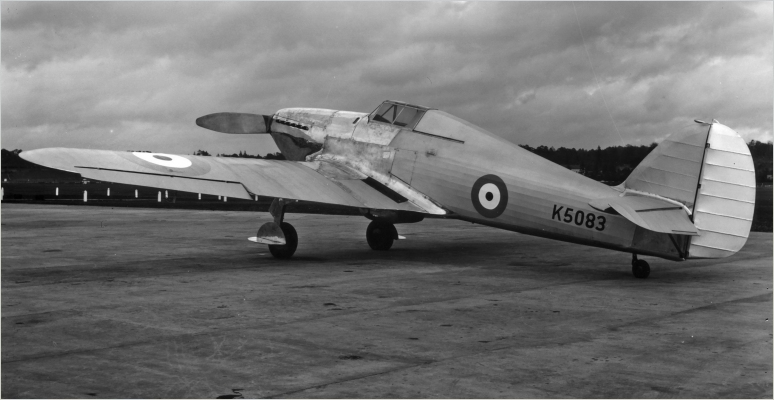
Hurricane Prototype (K5083) © Wingleader Archive
First RAF Ace of the Second World War Flying Officer Edgar Kain, known as Cobber Kain, was born on the 27th June 1918 in Hastings, New Zealand. Flying a Hurricane with No. 73 Squadron became the first Royal Air Force ace of the Second World War when he shot down his fifth aircraft on the 26th March 1940. He would shoot down a further eleven aircraft before he died in a flying accident on the 7th June 1940 aged 21. Fighter Command's Only Victoria Cross Flight Lieutenant James Brindley Nicolson would be the only Fighter Command pilot to be awarded the Victoria Cross during the Second World War. This was for his actions on the 16th August 1940 when, despite his Hurricane Mk I (P3576) being damaged by Messerschmitt Bf 109s, he shot down a Messerschmitt Bf 109 before bailing out (read the citation). Flown by Douglas Bader Squadron Leader of No. 242 Squadron during the Battle of Britain Douglas Bader flew the Hurricane Mk I, during this period he is credited with 11 aircraft destroyed, 4 damaged and 1 probable. Sir Keith Park's Personal Aircraft During the Battle of Britain Air Vice-Marshal Keith Park who commanded No. 11 Group, Fighter Command would often visit airfields under his command in his own Hurricane Mk I, OK-1. Top Scoring Battle of Britain Squadron Equipped with the type it was No. 303 (Polish) Squadron that would be the highest scoring squadron during the battle claiming 126 aircraft. This achievement was all the more remarkable as the squadron didn't become operational until the 31st August 1940. 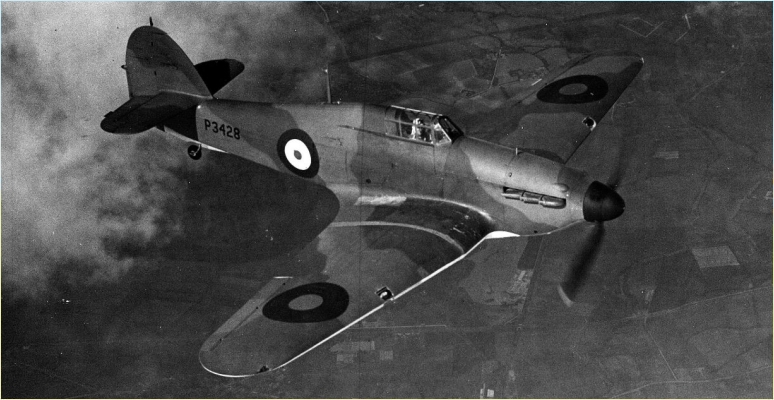
Hurricane Mk I (P3428) © Wingleader Archive
Hero of the Battle of Britain During the battle Hurricanes flew around 35,000 operational sorties and would shoot down over 50% of all German aircraft claimed, more than other aircraft, including the Supermarine Spitfire , and ground defences put together. Parasite Fighter To help with attacking Luftwaffe aircraft at night, Hurricanes would work alongside Douglas A-20 Havocs with a Turbinlite searchlight installed in the nose of the aircraft and fitted with Airborne Interception radar. This would see the A-20 Havoc illuminate the enemy aircraft allowing the Hurricane to attack it. Alternative Engines With the Rolls-Royce Merlin in high demand two proposals were suggested that saw alternative engines considered for the Hurricane. The first was the Napier Dagger engine during 1940, with 1941 seeing a proposal for a Bristol Hercules powered Hawker Hurricane. Neither of these would progress further than the drawing board. A Rolls-Royce Griffon powered Hurricane was also considered but went no further with the Hawker Typhoon being preferred. Naval Hurricane Known as the Sea Hurricane, the Mk IA, nicknamed Hurricats, served aboard catapult aircraft merchantmen ships. A rocket propelled catapult would launch the aircraft when needed, but as there was nowhere to land back on the CAM ship, the pilot would have to bail out or ditch in the sea and await rescue. It was the Sea Hurricane Mk IB that was the first variant that could be used aboard an aircraft carrier, it would be the Fleet Air Arm's first single-seat carrier fighter. It would also serve aboard merchant aircraft carriers and catapult aircraft merchantmen ships. 'Flying Can Openers' One of the more successful variants was the Hurricane Mk IID 'Tank Buster'. Fitted with a redesigned wing, it enabled a 40mm Vickers 'S' anti-tank gun to be installed under each wing with a single 0.303-in machine-gun to assist with aiming. December 1941 saw the prototype fly for the first time and the 6th June 1942 saw No. 6 Squadron perform the first operational sortie with the aircraft. So effective was this type against enemy armour, they would be nicknamed the 'Flying Can Openers'. 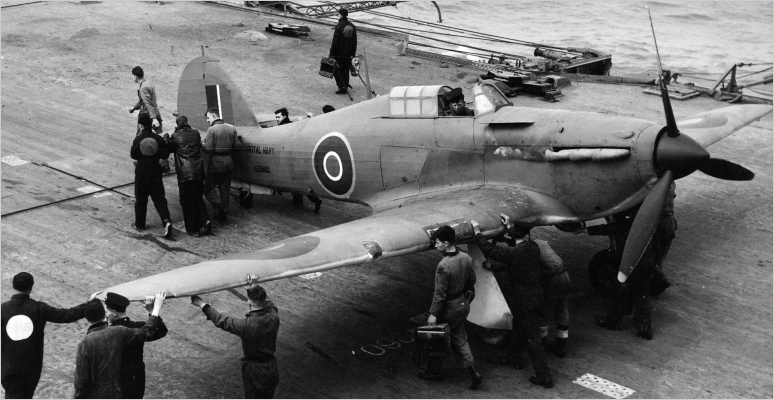
Sea Hurricane (AE962) © Wingleader Archive
“Dodo” Hurricane A rather unusual modification saw a written off Hurricane Mk I fitted with a third wheel under the nose and a seat either side of the cockpit, one for a second pupil and the other for an instructor. It was then painted in stripes. The idea behind this unusual Hurricane was to improve the taxiing skills of new pilots. Slip-Wing Hurricane One of the most unusual ideas tested on the Hurricane during the Second World War must have been the slip-wing. Known as the Hillson FH.40 Slip-wing Hurricane, this saw a Mk I (L1884) fitted with a top wing. This made the aircraft look like a Hurricane biplane but the extra top wing, which could hold extra fuel and help with lift on take-off, could be discarded when no longer required. First Use of Air-to-Ground Rockets It was the Hurricane Mk IV which would be the first aircraft to use air-to-ground rocket projectiles on operations when they were used on the 2nd September 1943. Laminar Flow Wing Test Bed Hurricane Mk IIB (Z3687), painted in an all white colour scheme, would be used during 1944 and 1945 to test a laminar flow wing designed by Armstrong Whitworth. Hurricane Users The type would see service with 25 air forces around the world. During the Second World War twelve were used by Romania, who used the Hurricane during Operation Barbarossa in support of the German invasion of the Soviet Union. Aside from the Royal Air Force one of the biggest users of the Hurricane was the Soviet Union who received 2,952 examples. 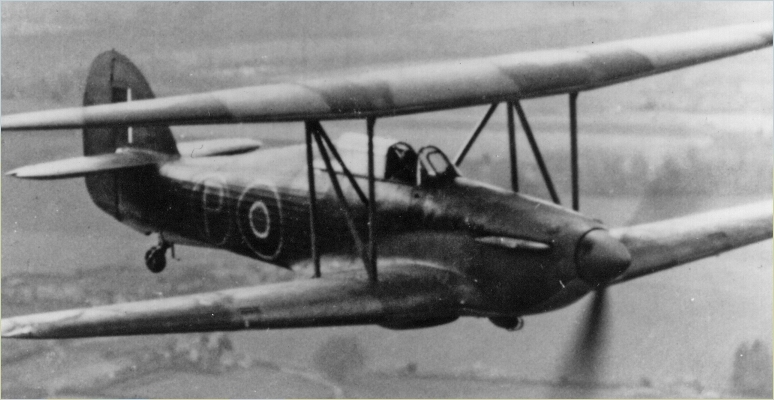
Hillson FH.40 Slip-wing Hurricane © Wingleader Archive
Japanese Hurricane Hurricane Mk IIC (BE208) of No. 232 Squadron, Singapore flown by Squadron Leader Richard Brooker had force landed at its airfield and ended up in a ditch, the pilot was unhurt, and when the airfield was abandoned as a result of the Japanese advance the aircraft was captured. After repairs it was tested by the Imperial Japanese Army Air Service. Last Hurricane Squadron 12 years service with the Royal Air Force came to an end with No. 6 Squadron. They would perform the last operational sortie of the type on the 13th January 1947 and were the last to have their Hurricanes, which were Mk IVs, replaced. This was two days later on the 15th January 1947 when they received the Hawker Tempest. Elsie MacGill When the Canadian Car and Foundry Company hired Elsie as their Chief Aeronautical Engineer in 1942 she became the first women to be employed in such a role and would oversee the construction of Hurricanes at the factory. Elsie would design a number of modifications to ensure the aircraft could still be used during cold conditions. Her work with the type earned Elsie the nickname 'Queen of the Hurricanes'. 'The Last of the Many' The last example ever built was a Mk IIC (PZ865) at Hawker Aircraft's satellite factory at Langley, Buckinghamshire and would be kept by Hawker and would not see active service in the Second World War. It flew in the King's Cup on the 17th June 1950 in the hands of RAF ace Group Captain Peter Townsend and finished second. It would appear in the Battle of Britain (1969) film before being handed over to the Royal Air Force Battle of Britain Memorial Flight on the 29th March 1972 and is still flying today. Total Built During the Hurricanes seven year production run between 1937 and 1944 a total of 13,132 were built in the UK by a number of different companies and 1,451 were built in Canada by the Canadian Car and Foundry Company. This brought total production of the aircraft to 14,583. 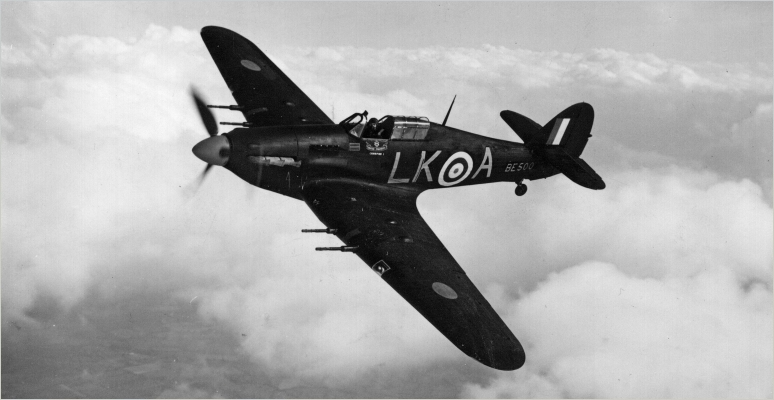
Hurricane Mk IIC (BE500) © Wingleader Archive
< Back to articles |
|
|
|
||||||||||||||
|